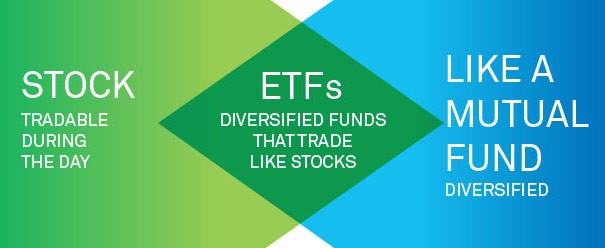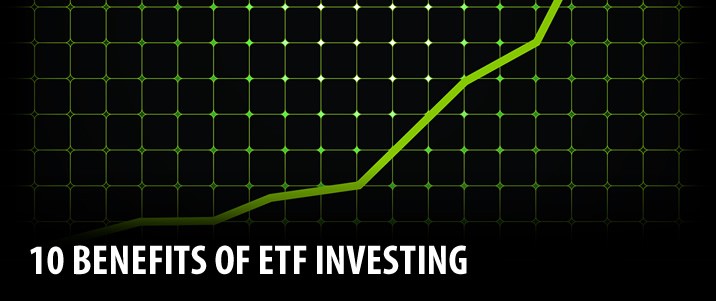10 Benefits of ETF Investing
Post on: 21 Июль, 2015 No Comment

10 Benefits of ETF Investing
Published on March 20, 2012 with 5 comments
To best appreciate the advantages of ETFs, we have to travel back in time to the pre-ETF or pre-index investment universe. In 1975, after a loss of over 40% during the bear market that lasted from January 1973 to December 1974, the first index mutual fund for retail investors was introduced by Vanguard. The fund unpretentiously mirrored the widely followed and diversified S&P 500.
The man behind the fund was John Bogle, a co-founder of Vanguard and a long-time proponent of index investing, contending that a simple strategy of holding the diversified index long-term coupled with low-costs will outperform most of the actively managed funds. After all, the devastation of the two-year bear was not avoided by the majority of active managers and their investors were no better protected after shelling out higher expenses for years.
Fast forward to 1993 when the first ETF was born— the now ubiquitous ticker SPY, also mimicking the S&P 500 index. The concept was obviously similar to Bogle’s, except that the SPY could be traded exactly like a stock on the market. Initially, Bogle had reservations about the ETF as the average holding period on it was very low (which went against his hold forever philosophy), yet Vanguard did end up joining the bandwagon by creating its own ETF of the S&P 500. Today, the SPY and Vanguard’s S&P 500 index fund and ETF combined, represent about 100 billion in assets each.
In total, the ETF market surpassed the 1 trillion-mark in December 2010. Today’s ETF industry, a far cry from the singular offer of owning the S&P 500 index only, has evolved into an extensive array of choices that the individual investor can use to deploy strategies ranging from the very simple to the most sophisticated.
1) Instant Diversification
The first and foremost benefit of an ETF based on a wide index such as the S&P 500 continues to be the access to instant diversification, as opposed to owning a concentrated portfolio of few stocks or an actively managed fund. Indeed, this goes hand in hand with the original idea that even most of the professional money managers cannot beat the index through their active management. As in the original conception of indexing for retail investors after the 73-74 bear market, this again rings especially true to today’s investors who saw the Great Recession wipe away their active funds’ outperformance as no down side protection occurred.
2) Lower Fees than Actively Managed Funds
While the SPY only charges 10 basis points (0.1%), a typical fund charges closer to 2% in total fees annually. In addition to the lack of talent pool that is necessary to beat the markets, the added layer of fees charged by active managers erodes an investor’s returns. For example, while the SPY only charges 10 basis points (one tenth of 1%), a typical fund charges closer to 2% in total fees annually. While this spread may not be noticeable in a year when the market prospers, year in and year out, over the long term, it significantly decreases the investor’s compounded returns.
To take the example of the SPY and a fund charging 2% yearly fees: if one assumes annual market returns of 10% over a ten-year time period, then what would be the difference between the SPY and a fund that matches the market returns before fees? For an investment of 10,000 dollars for the ten years, the ETF would amount to 25,700 dollars and the fund to 21,600 dollars — this is a weighty difference of 40% on the original investment. Of course, the longer the time period, the larger will be the difference.
3) No Exit Fees
Further on the cost aspect, the purchase of an ETF is only subject to whatever brokerage commissions the investor pays. These can vary from firm to firm, but overall have become very inexpensive if using an online broker. In stark comparison, many advisor-sold funds till today charge the investor a 5% load or similar exit fees. In the case of the ETF, the majority of the investment amount is put to work right away in the market.
Using the same example as above, if one adds a 5% load to the fund, then the end amount for the fund becomes 20,500. In this case, the difference between the returns of the fund and ETF is a drastic 50% of the original investment of 10,000 dollars.
4) Tax Advantages
Last on the cost attribute, ETFs (so far at least) have had an in-built tax value in contrast to mutual funds. As many investors realized in early 2000’s dotcom crash and more recently in the Great Recession, even when they lost money in the markets they had to pay capital gains on their mutual funds. This double insult is so because the taxes on mutual funds are calculated by the cost basis established by the fund’s buys and sells, and not when the investor purchases or sells the fund.
As many investors realized, even when they lost money, they had to pay capital gains on their mutual funds. For instance, if a technology fund bought a high-flyer in the early 90s for 10 dollars, and then the investor bought the fund in 1999 when the same stock was trading for 100 dollars, and the fund sold the stock for 50 dollars in 2000 — guess what, the investor incurs a capital gain of 40 dollars (difference between original purchase price of 10 dollars and sale price of 50 dollars), even though in reality the investor lost 50 dollars (purchase price at 100 minus sale at 50).
When it comes to ETFs, the investor establishes his or her own cost basis on the day of purchase itself. There are practically no capital gains to be paid until the investor sells the ETF — and that only if the investor makes a profit.
A related benefit is that the ETF investor has more control over her specific tax situation. Say if an investor wants to liquidate a portion of her investment in December but wants to delay taxation, she can decide to sell the ETF in the following year of January. On the flip side, tax losses can be created if needed in a given year.
5) Transparency
Another key advantage of ETFs is their transparency. At any given time an investor can see what the ETF owns. Basic as this may sound, the significance of this cannot be overemphasized in light of recent happenings in the markets. From the Madoff debacle to the AAA-rated subprime mortgage fiascos, investors are wary (or, in any case, should be) of what they own in their portfolio.
While fraud is indeed not the norm, an active manager can also be temporarily outperforming bull markets by holding more aggressive positions than mandated by his fund — when the down swing comes, which it inevitably does, the aggressive positions reveal their risky nature by going down further than the markets. In the case of the ETF, the investor is assured there is no style or risk drift to chase performance.
6) Easy Asset Allocation
Using these fundamental benefits of diversification, cost, taxes, and transparency, the current availability of an abundance of ETFs allows an investor to implement an asset allocation strategy with ease and confidence. Say an investor decides that he wants to hold a portfolio comprising 60% stocks and 40% bonds. This simple strategy can be implemented by buying proportionate amounts of a stock index ETF and a bond index ETF. If the investor wishes to rebalance the portfolio at any time, he has to merely execute the same two trades again.
7) Many Asset Allocation Options

Additionally, if the investor does not want to be too involved, he can opt to purchase an ETF that mirrors his desired asset allocation. The ETF will pursue a 60/40 strategy by investing in the corresponding indices and automatically reallocate on a quarterly basis.
Actually, if the investor wishes to have a more sophisticated diversification with an allocation that takes into account the style of stocks (growth and value, small, mid and large cap), the geography (domestic, international, and emerging), the nature of bonds (long term and short term, government and corporate, high quality and junk), some alternatives (say, real estate)…all this can today also be purchased through one ETF.
Further, if the investor is not sure of what type of asset allocation to follow but has an approximate retirement date in mind, an ETF targeting a retirement year can be bought that will gradually make the asset allocation more conservative as it approaches the targeted year. (Keep in mind that in the one-stop asset allocation and target-date ETFs, there is an increase in cost and taxes, as the strategies require a dynamic asset allocation.)
8) Access to Commodities, Bonds, Real Estate and Other Markets
For the more involved investor, ETFs can be used to build a customized portfolio that reflects her particular biases of the markets. For instance, if she wishes to allocate 10% to commodities to hedge against inflation, she can purchase a combination of ETFs tracking the price of gold, oil, and coal. Moreover, if a particular emerging country is deemed to have more potential than the overall foreign markets, chances are there is an ETF for that country (besides the usual suspects such as Brazil, Russia, India and China, now there are ETFs for countries like Egypt, Poland, and Indonesia). Also, if a particular industry or sector such as healthcare or consumer goods is viewed as more promising, they can be accentuated in the portfolio. Likewise for bonds.
9) Bond Flexibility and Monthly Distributions
Specifically to bonds, while most individual bonds provide semi-annual payments to the bondholder, many bond ETFs provide monthly distributions. This can be used very effectively by an investor that has monthly cash flow needs. An ETF portfolio can be assembled with risk tolerance in mind that provides the predictable income stream. Indeed, that can be done by building a portfolio from individual bonds, but that normally requires a relatively large investment as most bonds are sold in 1000 dollar denominations.
Once again, with the current availability of many bond ETFs, the investor can customize his fixed income portfolio to reflect his preferences for taxation (municipal or taxable bonds), risk (from treasuries to high yield), income (current income or inflation protection), and interest rate prediction (short, intermediate, or long term).
10) Advantages for Active Traders
There are many advantages for the aggressive short term trader. We have focused on the benefits of ETFs for the somewhat longer term oriented investor, but there are many advantages for the aggressive short term trader also. To begin with, since the ETFs’ trade similar to a stock, an active trader can buy and sell any number of indices intra-day, either at the market price or with limit triggers. Also, the ETFs can be shorted — often an important element for the day trader’s tactics.
For the more popular ETFs such as SPY or QQQ, there is an active derivative market allowing the trader to create complex option strategies. An extra layer of sophistication can be added with ETFs which track the market’s volatility intra-day. Last, a trader can execute any of these strategies by employing margin, and since there are already leveraged ETFs (both directly and inversely related to the markets), significantly raise his leverage.
ETF Investing
ETFs come with many benefits and it is truly up to each and every individual investor how to use them with varying degrees of involvement and sophistication. There are many incremental benefits for the long term investor and the short term trader now has tools previously reserved for institutional investors. In a sense, ETFs have led to a democratization of the investment universe. And that might be the biggest advantage of all.














